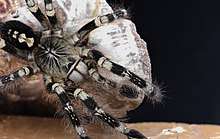Poecilotheria subfusca
| Ivory-billed ornamental tarantula | |
|---|---|
 | |
| Mature female | |
| Scientific classification | |
| Kingdom: | Animalia |
| Phylum: | Arthropoda |
| Subphylum: | Chelicerata |
| Class: | Arachnida |
| Order: | Araneae |
| Infraorder: | Mygalomorphae |
| Family: | Theraphosidae |
| Genus: | Poecilotheria |
| Species: | P. subfusca |
| Binomial name | |
| Poecilotheria subfusca Pocock, 1895[1] | |
| Synonyms[1] | |
| |

Poecilotheria subfusca, or the ivory-billed ornamental or montane tiger spider, is an arboreal tarantula. It is endemic to Sri Lanka. It is one of the largest Poecilotheria recorded from Sri Lanka. Often mistakenly referred to as Poecilotheria subfusca "Highland" or Poecilotheria bara,[2] bara has become synonymous with subfusca.
Size
Female body length reaches 7–8 cm.[2]
Identification
The species can identified from other tiger spiders by prominent white stardust pattern around fovea on dorsal surface and by totally black ventral surface.[3]
Female
Dorsally, there is a light patch behind ocular tubercle and white stardust patter around fovea. Carapace is pale. Opisthosoma is dark greyish brown colored with pale chevrons. The light foliate median band goes down to end of opisthosoma. Chelicerae are pale colored.[3]
All four pairs of legs are identically marked. Femur is black colored with distal cream band. Patella is creamy. There are two parallel lines of oblong yellowish spots prominent against black colored tibia.
Ventrally, all four leg pairs are identical, with entirely black surface.
Male
Dorsally, brown colored and markings are less distinct. Opisthosoma has a dark spot on median band. Ventrally, all four pairs of legs are identical to female.[3]
Ecology
The Montane tiger spider inhabits montane regions of Sri Lanka and found within tree holes, under rocks, and human dwellings. When disturbed, it is very nervous and jumpy, and no hesitation to bite.[3]
References
- 1 2 "Taxon details Poecilotheria subfusca Pocock, 1895". World Spider Catalog. Natural History Museum Bern. Retrieved 29 February 2016.
- 1 2 "BTS31(3)_subfusca_Jacobi.pdf" (PDF). Dropbox. Retrieved 2018-03-02.
- 1 2 3 4 Nanayakkara, Ranil P. (2014). Tiger Spiders Poecilotheria of Sri Lanka. Colombo: Biodiversity Secretariat, Ministry of Environmental & Renewable Energy. p. 167. ISBN 978-955-0033-58-4.
